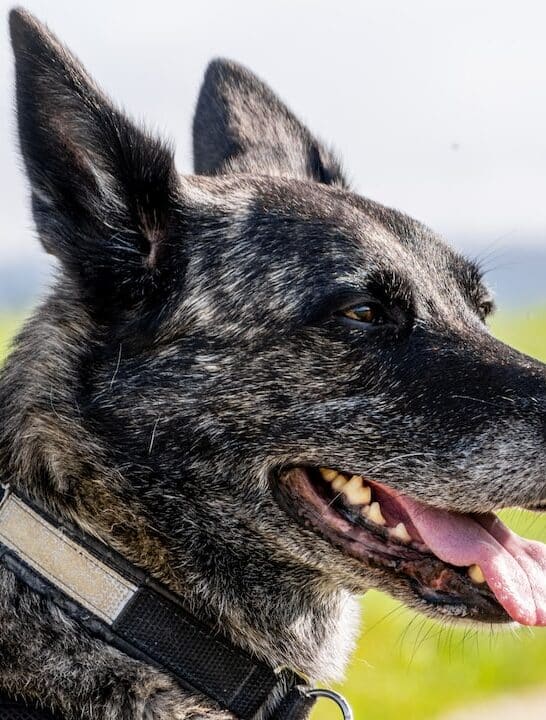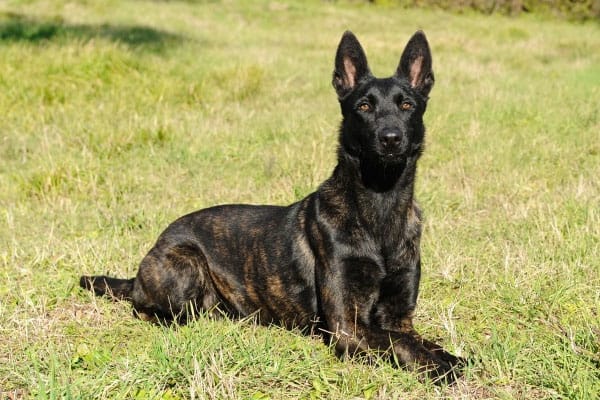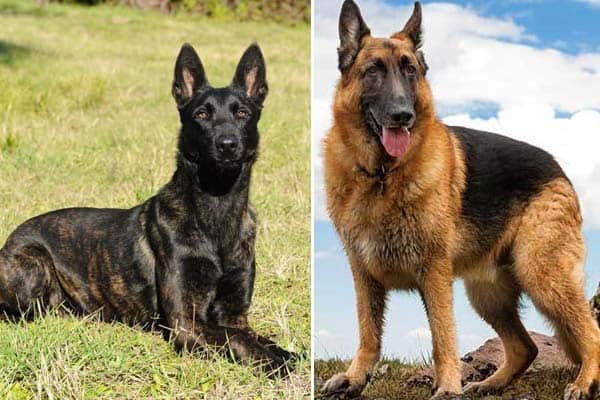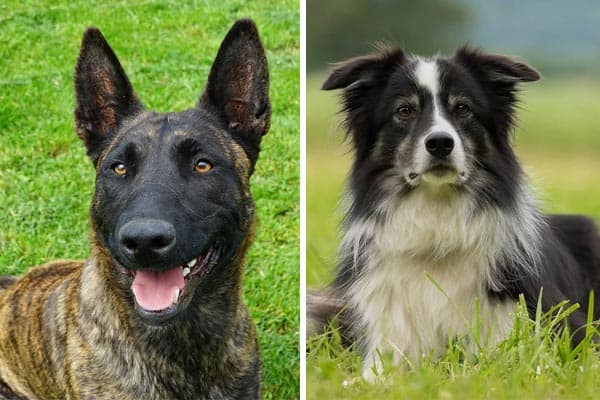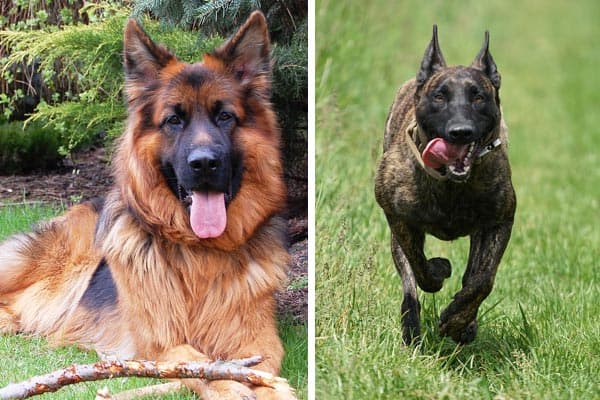Dutch Shepherd Dog Breed: Why Should you Care About It
How often does someone ask you, “What is your favorite dog breed?” To what lengths would you go to preserve it?
You may not be very familiar with the Dutch Shepherd, but people much like yourself were passionate about saving the breed from certain extinction.
What is a Dutch Shepherd? Is it yet another German Shepherd type. The Dutch Shepherd, as the name indicates, is a medium-large herding dog from Holland. He is a loyal and steady companion.
Despite a tumultuous history that seemed to center around coat type and color, the Dutchie is a remarkable working dog that rivals the German Shepherd in versatility and companionship.
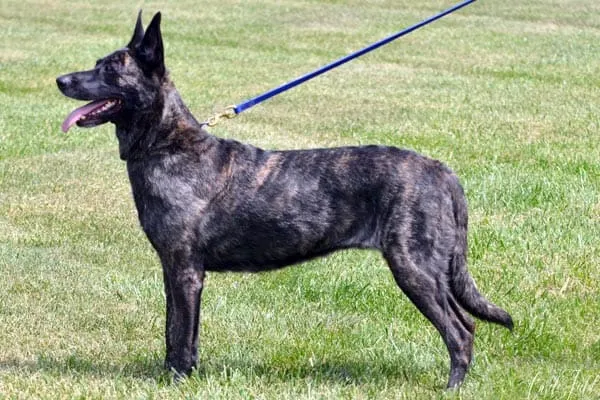
How did Dutch Shepherds get here?
Dutch Shepherds originated from a pool of generic herding dogs that also gave rise to the German Shepherd and eventually four varieties of the Belgian Shepherd. The Dutch Shepherd mainly developed in the Southern Netherlands near Belgium alongside the Belgian variety.
The three main Northeastern Shepherd breeds separated beginning in 1892 with the Belgian Shepherd breaking off first.
The Dutch Shepherd breed standard originated in 1898, a year before the GSD, but the DS shared a close link with the Belgian Shepherd until 1914. In fact, until that year, Belgian and Dutch Shepherds were often at the same shows, exhibitors interchanging the breeds regularly.
How did Dutchies almost disappear?
World War II was a harsh time for most dog breeds. People had little to eat with rationed supplies, and dogs often suffered from abandonment and starvation. The Germans quickly took any dogs deemed valuable, most put to work in military efforts.
Dutch Shepherds were hit particularly hard as the Netherlands shut down all breeding programs. The dogs had already suffered a sharp decline in demand and numbers with the revolution of farming practices in the early 1900s as forest reclamation and projects to create more arable land took place.
It is possible during military times that isolated pockets were able to sustain the salvation of a few dogs, similarly to canids in other countries like Japan with the Akita.
When the Germans confiscated Dutch Shepherds, they preserved very few of the original bloodlines, likely breeding most dogs to German Shepherds. The Dutch Shepherd approached the brink of extinction.

How do you preserve a dying breed?
Believe it or not, extinction and endangerment are not rare in dogs. Dog breeds fall out of favor for various reasons, including loss of their purpose, public disenchantment with their looks or temperament, increasing health problems, infertility, and changing lifestyle.
A life change example is urban living increasing the demand for small dogs at the expense of larger breeds.
Purebred dogs have seen huge fluctuations in demand, depending on economic status and public perception of vitality.
Glamorous televised conformation shows and Hollywood tales of overcoming adversity seem to spark almost romantic interest in the purebred dog, but wartime and depression often put the pedigree canid at the bottom of priorities.
The designer dog’s appearance on the scene and its explosion in the 1980s has likely contributed to the decline of several purebred dogs and perhaps a surge of interest in others. Designer dogs have exposed the conflicts between preserving the original intent of the purebred dog and improving health.
Sometimes mixed breeds draw people together towards the common goal of restoring original function and lessening gross character exaggerations. In other instances, crossbreeding has saved endangered purebreds.
The Dutch Shepherd had numerous factors working against it
Stiff competition from two similar breeds who filled almost identical roles – GSD and races of Belgian Shepherds.
Industrialization of agriculture, loss of large herds of roaming livestock – Dutch Shepherds did not adapt as fast nor did they receive the marketing the German Shepherd did.
Drastic measures to distinguish the dog as a separate entity limited the Dutch Shepherds available to breed
The Dutch Shepherd experienced some outcrossing with the GSD from 1910 to 1916 to attempt to produce larger dogs for the police force. DS fanciers were not pleased with the results and spent generations trying to reverse some of the changes.
We never saw mention of any specific undesirable traits, but educated guesses are hip and elbow dysplasia, increased black coloring, and changes to the gait and coat quality.
Some changes were probably positive, but not for people who were looking for a separate breed rather than another GSD type.
World War II brought about the assimilation of Dutch Shepherds into German stock. The war halted Dutch Shepherd breeding in the Netherlands and ravaged the country, bringing hardship to many dogs.
After World War II ended in 1945, Dutch Shepherd lovers took stock of the critical status of the breed and worked to revive it. Dogs of mixed-breed ancestry were among the possible candidates to infuse fresh blood.
However, the Belgian Malinois was likely the most common outcross, a practice that breeders soon abandoned. Similar to the GSD matings, undesirable traits for the DS standard began to creep in with persistent crossings with the Malinois.
Officially, the Dutch Shepherd Club approved an outcross with a Belgian Tuveren in 1984 to revitalize the long-haired genetic line.
The resulting offspring were subsequently bred back to long-haired Dutch Shepherds until F3, and F4 dog could enter the club.
Briefly, an F4 dog is a puppy that results from breeding hybrids to each other for several generations. F3 dogs first begin to pass traits reliably to their puppies, the gold standard for purebred dogs. In this case:
- F1 – Purebred Belgian Turveren x Purebred Dutch Shepherd >>Puppies are short-haired.
- F2 – Belgian Turveren Dutch Shepherd hybrid x Belgian Turveren Dutch Shepherd hybrid or F1 x F1
- F3 – F2 x F2
- F4 – F3 x F3
Another method to expand the longhaired gene pool was to interbreed coat types, a practice the Dutch Club usually discourages. The Dutch Club’s position is that interbreeding dogs with different coat types negatively impacts fur quality.
Nevertheless, the Raad van Beheer, according to the American Dutch Shepherd Association, will permit carefully-orchestrated interbreeding of coat types in the Netherlands until 2034.
Puppies from the crossing of a short-haired and long-haired Dutch Shepherds have the designation of Appendix Dutch Shepherd and have a Bilj marker after their names in the registry.
Similarly to F generations, results of coat crosses are G-0 through G-2. Puppies from G-2 dogs bred with regular or main studbook longhaired Dutch Shepherds achieve regular status.
- G0 – Longhaired x Shorthaired
- G1 – First-generation longhair/shorthair cross x normal longhair
- G2 – G1 x G1 or G1 x normal longhair
- Normal longhair – Comes from generations of normal longhaired dogs or G2 x normal longhair
The Dutch Club had similarly granted permission in 1959 to use a Belgian Laekenois to expand wire-haired Dutch Shepherd numbers.
Why does it have to be so complicated? – The KVPN Dutch Shepherd
Also concerned with the fate of the Dutch Shepherd was the Royal Dutch Police Dog Sport. They had a different angle than the FCI, however, more in keeping with Stephanitz’s goals for the importance of the functional versatility and ability in the GSD.
The KVPN hoped to preserve the Dutch Shepherd by expanding its usefulness beyond the pasture. Breeders increased the available DS gene pool by breeding, sometimes extensively, with the Belgian Malinois.
Ultimately, working ability became far more important than the original breed standard and appearance. The KPVN Dutch Shepherd is still brindle in color, for the most part, with three different coat types.
However, some dogs have a large proportion of Malinois, and the Dutch Shepherd Club will not allow these dogs access to AKC consideration.
Many KVPN Dutch Shepherd owners do not bother obtaining papers on their dogs. Nevertheless, KVPN Dutch Shepherds and KVPN Belgian Malinois remain in high demand around the world for police and military work.
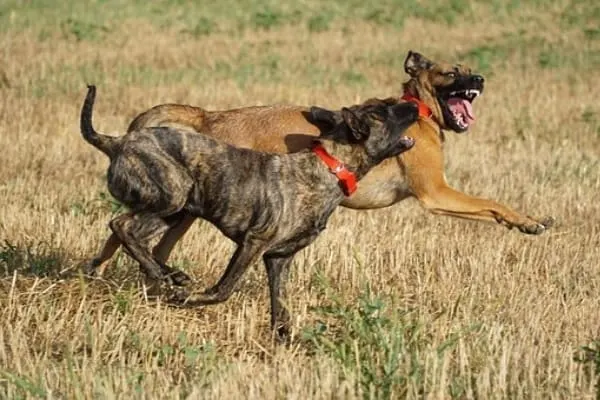
How do Dutch Shepherds differ in appearance from the GSD?
Size
Dutch Shepherds are medium-sized dogs, moderately smaller than German Shepherds. Males are 22.5 to 24.5 inches tall at the shoulders while females are an inch shorter. Dutch Shepherds weigh between 50 to 70 pounds, with females only slightly smaller than males.
The Dutch Shepherd standard does not call for the difference between genders that the GSD exhibits.
The Conformation and General Appearance
Similar to working line German Shepherds, Dutchies are longer than they are tall at a ratio of 10:9. Dutch Shepherds are muscular and give an impression of liveliness and balance.
Balance begins with the head, which should appear in proportion to the body. A Dutch Shepherd’s head is wedge-shaped and dry, which means no wrinkles or droopy skin.
In appearance, a Dutchie’s head is more triangular than the GSD’s and coarser than the Belgian Malinois’. There is only a slight stop or dip from the forehead to the snout.
The eyes are almond-shaped, and the ears medium, upright, and often carried slightly forward of erect. Some feel the Dutch Shepherd most closely resembles the wolf in expression among all the Northern European Shepherd dogs.
Dutch Shepherds have a deep and somewhat broad chest and a level back. They experience no exaggeration of any traits, sticking to the moderate angulation of the pasterns and hocks. The pastern is the joint just above the paw, and the hock is the large bend of the hind leg below the knee.
A Dutch Shepherd’s tail is long enough to reach the hocks and slightly curves at the end or is straight. When moving or animated, Dutch Shepherd carries their tails up without it curling or reaching over their backs.
Dutch Shepherds have a unique way of moving in that it is conservative, involving no powerful drive from the hindquarters or overreach with the front legs. Dutch Shepherds are trotting dogs who track directly underneath their bodies with their rear legs.
Brindle is the Dutchie’s legacy
The Dutch Shepherd’s crowning glory is the color that sets her apart from the other Shepherd breeds. However, color may have also played a large role in the downfall of DS numbers and the limited success in reviving the breed.
In the late 1800s, as the Dutch Shepherd was splitting from the German and Belgian Shepherds, he could be any color. A breed standard took form in 1898 and included solid shades like liver, blue, and red. Another acceptable color was yellow, which was similar to fawn when paired with a black facial mask.
In a focused effort to cement the individuality of the breed, the Dutch Shepherd Club decided in 1914 that the only acceptable color for a DS was brindle and forbade all white markings.
Confusion persisted in the breed standard when in 1934, the original standard colors were once again acceptable. The allowance for colors other than brindle may have taken into consideration the addition of outside breeds in an attempt to expand the gene pool and increase the Dutch Shepherd’s critically low numbers.
The breed standard as of 1928 also allowed Dutchies to have white markings as long as they were restricted to the chest and toes.
In 1960, the color standard reverted to 1914 restrictions except for that red or auburn long-haired Dutch Shepherds were no longer acceptable. The current Dutch Shepherd breed standard allows for sparse areas of white on the chest and toes.
Today all Dutch Shepherds must be brindle of two types
Gold Brindle
Agouti Base- a often designates the agouti locus.
Dutch Shepherds typically display the ay base, not the others. The following colors are in order from most to least dominant among the agouti genes.
ay – Sable/fawn – Usually a shade of red from the lightest of creams and tans to orange to mahogany or chestnut. Dutch Shepherds are often golden to reddish-brown with brindle striping. Sable dogs have black-tipped hairs especially on their backs and tops of their shoulders and hips.
aw – Red or wild sable, a banded hair color characteristic in many wildlife species such as deer, coyotes, wolves, and badgers. Composed of reds, browns, yellows, and blacks, the color is true agouti and usually appears as an indistinct grayish-brown color perfect for camouflage in temperate regions.
at – Black and tan or tricolor dogs.
ab – Recessive black. Dogs will be solid black or black with minor points of tan.
Gold refers to the dog’s base color, on the agouti or A gene, and can range from pale cream to mahogany. When stripes appear, dog fanciers refer to that process as brindling. Brindle is on a different gene, named K, that can be one of the many influencers on the agouti base.
KB – If a dog has dominant black on the K gene, it will not allow agouti colors or patterns to express, and the dog will be black.
KBr – Brindling on the K locus allows agouti to express, but black stripes will disrupt or “brindle” the base color. Brindling is a complex mutation and has modes other than the K gene in certain breeds like the French Bulldog. Dutch Shepherds are usually agouti fawn or “as/as” with “Kbr/Kbr” on the K locus.
ky – The recessive k allows all agouti colors and patterns to express. For example, black and tan German Shepherds are “at/at” at the agouti locus; the pattern expresses because of “ky/ky” on the K locus.
Not only is KBr recessive to the dominant black gene, but another gene, the E locus, can also mask it. Dogs with a double copy of the recessive “e/e” trait on the E locus will be red or yellow, masking any brindling on K.
There is no reliable test for the brindling gene, but there is a good test for the recessive yellow. Conscientious breeders can screen for carriers of the color yellow.
The E locus also affects facial masks. Facial masking is dominant in dogs and preferable in Dutch Shepherds. If your dog carries one copy of Em on the E locus (e.g., “Em/E”), she will have a dark mask over her muzzle and eyes that may extend to her ears.
Silver Brindle
Silver brindle Dutchies are so pale as to be almost white, and their stripes appear a dilute gray. A silver brindle Dutch Shepherd is exceedingly rare and must not be a true white base color, grounds for disqualification.
Salt and Pepper or Blue Gray
Wire-haired or rough-coated Dutch Shepherds often present as salt and pepper or an indistinct gray because you cannot see the brindle color. Once you strip these dogs, the brindle becomes apparent. You should not usually shave a double-coated dog, but a clipped wire-haired Dutchie will also better illustrate the brindle color.
Poorly understanding color genetics, Dutch Shepherd breeders began what would prove to be a detrimental practice of removing half their litters from their breeding stock, either destroying them or excluding them from the registry. The strict breed standard encouraged breeders to cull pups who were not brindle.
To further exacerbate the situation, white also became a forbidden color, and dogs with any markings faced elimination from the breeding.
Compounding the difficulty of obtaining uniform brindle in the breed was the fact that excessive black was undesirable. Experts are still unclear about the hereditary basis of a large number of black stripes in brindling and the width of the bands.
Of course, brindle dogs still passed undesirable colors because they carried recessive genes, so the pool of dogs who could breed continued to shrink. By losing focus on how brindles occurred in their litters, breeders failed to recognize carriers of solid colors.
Moreover, many genetic factors, like the loci mentioned above, determine the color of a coat and its pattern. Many breeders made a mistake initially of treating coat color as if it was a simple illustration of dominant and recessive genes.
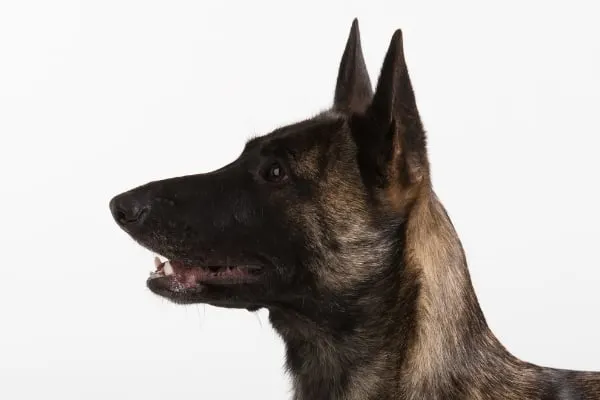
What health problems do Dutch Shepherds have?
Being rare has its benefits. The Dutch Shepherd breed, as of yet, experiences few of the genetic problems that are often the bane of popular and overbred dogs. Dutch Shepherds can live 12 to 15 years.
Allergies or atopy manifests as intense itching and can lead to secondary bacterial skin infections and hair loss.
Pannus – Also known as chronic superficial keratitis, pannus affects the cornea or outermost clear layer of the eye. It begins as pink growth and progresses to dark-colored scar tissue. According to VCA Hospitals, pannus most commonly affects German Shepherds, Border Collies, and Belgian Turverens. About 6% of Dutch Shepherds had eye problems in 2019. Untreated, pannus can cause blindness.
Inflammatory bowel disease – Symptoms can range from a sensitive stomach to severe vomiting and dehydration. Most cases are chronic involving diarrhea with intermittent flare-ups of digestive distress.
Cryptorchidism – Cryptorchidism is the failure of one or both testicles to descend into the scrotum. Sometimes one or both testes remain in the abdomen, and other times one will become lodged in the inguinal area (the Ring where the inside leg joins the hip).
Testicular cancer is 10 times more likely in a cryptorchid dog than one whose testes descend normally. The disorder is sex-linked, carried on the X chromosome in both sexes and, of course, only expressed by males with two copies of the gene.
Masticatory myositis – An immune-mediated disorder whereby the dog’s system targets the unique proteins of the chewing muscles and causes severe inflammation.
Hip dysplasia/elbow dysplasia – 8% and 5% respectively according to OFA data tracking during the year 2019. Dutch Shepherds have remarkable joint health compared to their German counterparts.
Other problems that may or may not be hereditary are:
Sensitivity to anesthesia
Dutch Shepherds often require far lower anesthetic drug doses than other breeds. Sensitivity involves increased respiratory depression during anesthetic procedures as well as difficulty or failure to arouse. The dramatic reaction of Dutch Shepherds can extend to pain medications.
Anesthetic hypersensitivity in Dutch Shepherds, not to be confused with the multidrug resistance gene common in Collie type, requires close communication with your veterinarian if you have concerns about potential surgery.
According to the Veterinary Practice News, there is no scientific basis of anesthetic hypersensitivity in any breed other than the Greyhound. However, the data does not discount special consideration when using anesthesia in breeds who show consistent adverse reactions in practical settings.
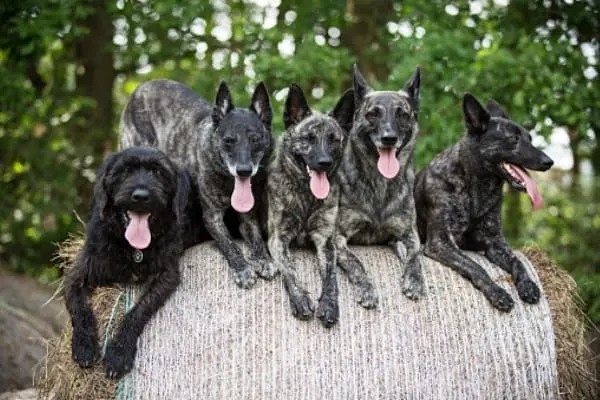
What kind of family pets do Dutch Shepherds make?
General Temperament
Dutchies are loyal, intelligent, affectionate, and lively. They have a strong working drive, happiest when they are busy with a regular job. Dutch Shepherds should never be shy nor aggressive. Their temperaments are steadfast with proper socialization, and they bond readily with all family members.
Do Dutch Shepherds get along with other animals?
Whether Dutch Shepherds get along with other animals depends on their lineage. Some working and sporting lines have high prey drives.
The original-type purebred Dutch Shepherds have a below-average predatory drive and were bred to get along with and work alongside other dogs. These old-fashioned working-stock dogs are generally amiable with everyone.
Dutch Shepherds make fine guard dogs
Most Dutch Shepherds make excellent guard dogs inheriting a guarding instinct, wariness against strangers, and protectiveness. They are vigilant, always with an eye out for any unusual activity.
However, Dutch Shepherds are discerning and even-tempered, not given to much barking or unprovoked attacks or posturing and overt displays of aggression.
Unlike German Shepherds, Dutchies easily warm to people you accept and will typically be friendly and even outgoing with regular family visitors.
Dutchies should do well with children
Dutch Shepherds, like several herding breeds, once had the chore of guarding children like their regular flocks. Dutchies appear to enjoy children but need supervision as their herding instincts remain strong. Your dog’s tendency to herd may spill over to toddlers.

What is grooming a Dutchie like?
All of a Dutch Shepherd’s coat types shed heavily in the spring and autumn.
Dutch Shepherds have a double coat that comes in three varieties.
Short-haired – Most common coat type. Dogs have smooth and coarse outer hairs that lie flat against a wooly undercoat. Although these dogs have short fur, they should have an obvious ruff about the neck, trousers on the hind legs, and a feathered tail.
Long-haired – Rare. Unlike other dog breeds, long-haired Dutch Shepherds do not have feathers or fringes on their ears although they have long bushy hair on their tails, feathers on their front legs, and pants on the hind limbs above the hocks.
Wire-haired –Extremely rare; Purists say you should never brush a wire-haired Dutch Shepherd. Instead, you utilize a grooming technique called stripping. Also called rough-coated, wire-haired Dutchies have obvious eyebrows, mustache and beard, and extensive feathering of the tail.
What is stripping?
According to the American Dutch Shepherd Association Inc, you should hand strip your wire-haired Dutchie at least twice a year. Show dogs may receive stripping as often as every three months.
Hand stripping a dog’s coat is a particular grooming technique that removes dead hair from the roots without causing pain to your pet.
If you are unfamiliar with the art, you should allow a professional groomer to show you a couple of times before you attempt it on your own. You may use your fingers or a special rake-like stripping comb.
To put stripping into context, a few breeds whose coats need to be stripped are Irish Wolfhounds, Wire-haired Dachshunds, Brussels Griffons, and Schnauzers.
Long-haired and short-haired Dutch Shepherds are relatively low-maintenance, not prone to matting, and require brushing once to three times weekly. Nails are black, and you trim them every six to eight weeks unless they wear down from exercise. You will need to attend a dewclaw on the forelegs.
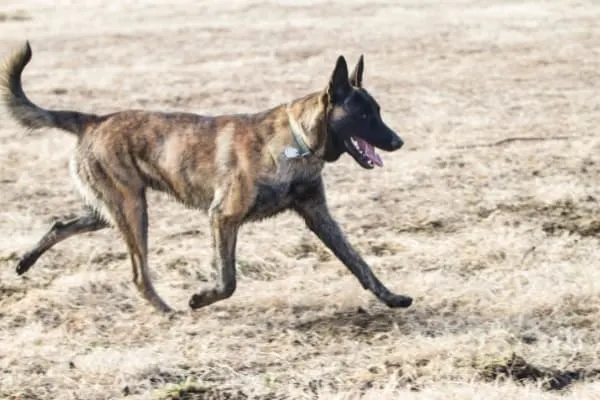
Like other Shepherds, Dutchies need a substantial amount of exercise to achieve happiness, health, and mental stability.
Your Dutch Shepherd will require an hour and a half to two hours of exercise every day. Plan on a rigorous regimen that includes time dedicated to mental enrichment and physical exertion.
Dutch Shepherds, like their German and Belgian counterparts, have herding prowess but are also versatile enough to be proficient at police and other activities.
Flyball – A type of dog relay featuring a short course over hurdles, flyball is gaining in popularity and features many other breeds besides the Border Collie and Australian Shepherd. Your dog’s main qualities should be speed and nimbleness for the turns in this sport.
Schutzhund – Dutch Shepherds usually excel at the protection phase of Schutzhund, although you can also test your dog’s obedience and herding instincts. According to Wagwalking.com, protection sports are an excellent means to teach your Dutch Shepherd discernment and restraint, even if you never intend her to be a guard dog.
French Ring – French Ring is quite different from Shutzhund, but many concepts judges expect the dogs to accomplish are the same. Shutzhund emphasizes more precise execution of the skills. Other Rings exist, such as the Belgian Ring, and dogs progress through a few levels.
Agility – Agility requires not only athletic ability from your Dutchie but also a strong link of communication between you and your dog. At competitive levels, courses can become complex and long, and your dog has no way of knowing the layout ahead of go time. This dog shows the brindle coloration and athleticism in a short-haired Dutch Shepherd.
Frisbee racing – Frisbee racing incorporates speed, distance, and technique at more competitive venues.
Dock diving – Traditional dock diving dogs are Retrievers, but the Belgian Malinois has recorded remarkable leaps. A Whippet holds the current dock-diving world record.
Herding trials – Herding trials allow you to learn skills along with your dog and help you get in touch with the Dutch Shepherd’s original purpose.
However, many trials are geared towards the herding style of Border Collies which means you must teach your Dutchie a strong eye type herding or search a little deeper for competitions that cater more to the Grman Shepherd’s technique, similar to his own.
Are Dutch Shepherds smart?
Dutch Shepherds were not one of the breeds Stanley Coren recognized. Known for his list of intelligent dogs, Coren excluded dogs who were not members of the AKC.
However, Dutch Shepherds show learning abilities that are comparable to other herding dogs, and their intelligence has allowed them to excel as police dogs.
However, Dutch Shepherds have an inborn ability to work independently, and thus, can be stubborn. They, like other Shepherds, look for strength in leadership and are not pushovers for the inexperienced dog owner to train.
Working with a professional can ease communication between dog and novice and seasoned owners alike.
As far as intelligence ranking, Dutch Shepherds would likely fit into the above average or excellent working dog class, possibly getting minor penalties for obedience but extra stars for working instinct.
They would probably be in the proximity of the Belgian Malinois, maybe slightly lower because of their independent natures.
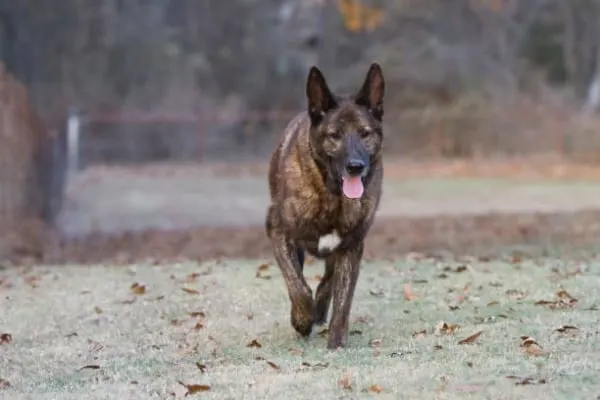
Dutch Shepherds remain rare and just outside the AKC
It might surprise you to learn that the Dutch Shepherd is not yet a fully recognized breed of the AKC. The AKC accepted the Dutch Shepherd into the AKC Foundation Stock Service in 2012.
The FSS, as it is known, keeps track of purebred dog registrations of breeds not yet members of the AKC. In the case of the Dutch Shepherd, the NHC records purebred representatives of the breed.
In 2017 the AKC accepted the Dutch Shepherd into the Miscellaneous Class, the last step before full recognition. Dutch Shepherds still must undergo population tracking and compete in specific and sanctioned events like club competitions and judge’s workshops.
They can participate in numerous AKC competitions including lure coursing, showmanship, herding trials, and tracking.
The AKC has already selected a provisional spot in the Herding Class for the Dutch Shepherd. On a similar timeline as the Dutch Shepherd, the Barbet and Dogo Argentino just fully joined the AKC in 2020.
Parallelling the Dutch Shepherd in its rarity and stiff competition from other water sporting dogs, the Barbet became one of the newest members of the AKC in 2020.
Once in the provisionary Miscellaneous Class with Dutch Shepherds, Barbets give hope that the DS will not be far behind in full AKC acceptance.














